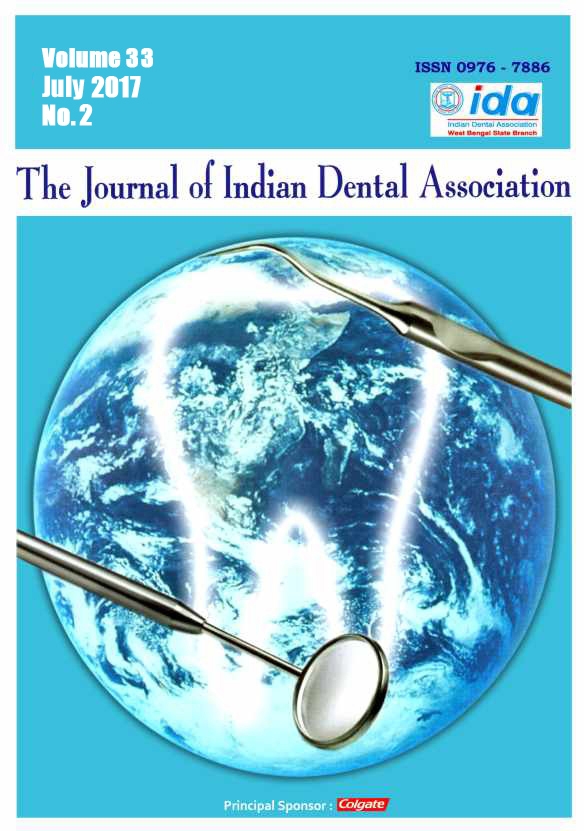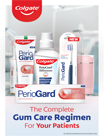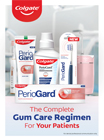Upcoming Events
1. Article Title.
2. Author Details.
3. Abstract.
4. Keywords.
5. Corresponding Author details.
July 2017
Volume : 33
No.: 2

Dr. Suranjita Das,Dr. Debaprasad Das,Dr. Asim Maity
Abstract: Aim: Evaluation and comparison of the sealing ability of three different obturation techniques - namely obturated by lateral condensation, using Thermoplasticised guttapercha, with Cold flowable guttapercha, with the help of a stereomicroscope at 40× magnification. Materials and Methods: Thirty extracted lower first premolar teeth were selected. The canals were shaped with ProTaper rotary files. Irrigation was performed with 5% sodium hypochlorite and 17% EDTA. The teeth were then separated into three groups depending on the type of obturation technique. Group A (number=10)-obturated using the Lateral condensation technique with AHplus sealer, Group B (number=10)-obturated with injection-moldedthermoplasticized technique with AHplus sealer and Group C (number = 10) obturated using cold flowable guttapercha technique. The teeth were stored in 100% humidity for seven days at 37º Centrigade, the roots of the teeth were sectioned at three levels. These sections were then observed under a stereomicroscope at 40 × magnification and the images were analyzed for area of voids (AV) and frequency of voids. Statistical Analysis Used and results: The data on the voids in the root canals of the teeth were subjected to the 'ANOVA' test using the treatments and sections as explanatory variables. The results indicate that the differences in the voids in the root canals of the tooth were significantly different for the treatments as well as the sections. The post hoc Tukey test indicates that the differences with the three groups were significantly different. Similarly, the apex and cervical sections were significantly different when the post hoc test was considered for the section pairs. Conclusion: Thermoplasticised guttapercha exhibited the best adaptation with no of voids, as compared to the other two groups and the sealing was dense in all the three sections followed by the lateral condensation group and cold flowable guttapercha group.
Dr. Paromita Mazumdar,Dr. Chiranjan Guha,Dr. Rupankar Dey,Dr. Utpal Das
Abstract: Aim: Re-attachment of crown fragment in fractured anterior tooth- report of two cases. Methodology: Crown fractures are the most frequent traumatic injuries that affect the permanent teeth. The high prevalence of fractures in permanent anterior teeth in young patients often represents a challenge for achieving aesthetic dentistry quickly and conservatively. In the first case, a 3mm horizontal fracture line was seen supragingivally at the labial and palatal aspect of the maxillary central incisor (11).Treatment was done by stabilizing the undisplaced fracture fragments using glass-ionomer cement, root canal therapy and fibre-optic post (Coltene) attaching the fractured coronal fragment which gets reinforced with the same post. In the second case, Ellis class III oblique type of fracture extending mesio-distally into the subgingival tissue of maxillary lateral incisor (12). Single visit Endodontic treatment was done followed by reattachment of fracture fragment followed by fixed prosthesis. Conclusion: Reattachment of a tooth fragment is a viable technique that restores function and aesthetics with a very conservative approach in single visit and can be considered when treating patients with coronal fractures of the anterior teeth, especially in younger patients.
Abstract: The concept of Biologic Width is vital for the dental surgeons especially for the restorative dentists. The restorative margins should maintain the biologic width to ensure adequate form, function and esthetics of the dentition. The violations lead to complications like gingivitis, periodontitits, alveolar bone loss and improper fit of the restorative component. Preservation of the biologic width paves way for a longer life of the restoration with a healthy periodontium.
Dr. Shubhabrata Roy,Dr. Rajesh Khan,Dr. Richa Bansal,Prof. (Dr,) Sugata Mukherjee,Prof. (Dr,) Tapan Giri
Abstract: One may opt for removable or fixed treatment optionsto replace a missing front tooth. Patient acceptance is always better with fixed options. But these options are expensive and may not be practically feasible in all situations.Proper abutments are required for conventional FPDs and adequate bone isneeded for implant placement. Maryland bridge is another conservative treatment option where minimum amount of tooth reduction is required. The dual cure resin cements have significantlyimproved the performance and survival of Maryland bridge. In this case report, a missing lower incisor has been replaced by a Maryland bridge.
Dr. Sahoo Rahul,Dr. Rambabu D.,Dr. Dholey Kanti
Abstract: Background: Chronic periodontitis is a multifactorial disease resulting in the inflammation and destruction of the supporting structure around the teeth. This leads to tooth mobility and subsequent loss of tooth. Although horizontal bone loss is most common, vertical bone loss is more amenable to regenerative periodontal therapy. Previously, various bone graft materials have been tried for management of osseous defects resulting from the disease process. However, the trend has now shifted towards application of endogenous regenerative therapy. The recent introduction of Choukroun's Platelet Rich Fibrin (PRF), has revolutionized the field of dentistry. PRF, a rich source of autologous growth factors and cytokines, is an upcoming therapeutic approach in the management of periodontal osseous defects. Aim:To present clinical and radiographic results of a wide intrabony periodontal defect treated withhydroxyapatite bone graft along with platelet-rich fibrin (PRF). Methodology:10ml of patient's venous blood was collected and PRF obtained after centrifugation. The platelet concentrate obtained was used in combination with a bone graft in an intrabony defect in relation to tooth 37. Surgical therapy by means of open flap debridement and for the management of the osseous defect, placement of a combination of autologous PRF and hydroxyapatite bone graft was done. Result: At the 6 month recall a reduction in the Probing pocket depth (PPD) from 11mm (Pre-operative) to 4 mm and clinical attachment level (CAL) from 12 mm (Pre-operative) to 6 mm (post-operative) at 6 month recall was observed respectively. Conclusion: The combination therapy using platelet rich fibrin with hydroxyapatite bone graft is a rapid, effective and promising grafting modality for the management of infrabony osseous defects.
Abstract: The Zimmermann–Laband syndrome, also often termed as Laband–Zimmermann syndrome or Laband's syndrome, was first described by Zimmermann in the year 1928. It is one of the rare inherited autosomal dominant disorders `clinically characterized by pathognomonic triad of extensive gingival enlargement, abnormalities of the nose and ears along with dystrophic nails. The syndromic characteristics are highly variable and is quiet complicated in nature. The present study describes a case report of a 17 years old female, presenting features of Zimmermann–Laband syndrome.
Abstract: The central odontogenic fibroma(COF) is a benign odontogenic neoplasm occurring within the jaw. The COF is a rare tumor that accounts for 0.1% of all odontogenic tumors. Radiologically It may be unilocular with well defined borders or multilocular. It responds well to surgical enucleation. We describe a case of COF in lower anterior jaw in a 35 year old female patient.
Dr. Manisha Barman,Dr. Amit Tirth,Prof. (Dr,) Amulya Barman,Dr. Minal Chakraborty,Dr. Vaibhav Tandon
Abstract: Aim- To assess oral health behaviour of 12 year old school going children in Purba Medinipur City, West Bengal. Materials and Methods- 840 students were selected from 8 private and 8 government schools. Data were collected in a specially designed proforma, analysis done by chi-square test. Results- 618 (73.6%) school children used to brush their teeth once a day. 780 (92.9%) school children used to clean their teeth with toothbrush while 59 (7.0%) used finger. 388(100%) in private schools used tooth paste; however, 395(87.2%) of govt. school children used tooth paste. Both school children 86.9% didn’t visit a dentist during the last 12 months. Conclusion- The levels of oral health knowledge and attitudes were predominantly low in government school children than private school children.
Dr. Baisakhi Mallick,Dr. Mandira Ghosh,Dr. Sushobhan Pramanik
Abstract: Xerostomia is the subjective sensation of oral dryness, usually, but not invariably, associated with hyposalivation. The major dental problems reported by xerostomic patients include a high caries rate, repeated failure of dental restorations, and early tooth loss that necessitate various degrees of prosthodontic treatment. Xerostomia is a relatively common complaint that can make the wearing of dentures very uncomfortable .To overcome this problem, a number of techniques have been proposed for incorporating reservoirs, containing salivary substitutes, into dentures. These have varying degrees of success. This paper presents a case of a patient suffering from xerostomia who was successfully treated with a new form of reservoir denture. This new partial denture technique resulted in a reservoir denture that provided good lubrication of the oral tissues, was easily cleaned by the wearer and was produced from routine dental materials.
Abstract: Patient safety and risk management together with quality and standards of oral healthcare are among important professional issues for dentistry. It can easily be seen that more and more emphasis is placed on these issues each year. Thus, dentists and their team members are expected to have a considerable amount of awareness, knowledge and concern for patient safety and risk management and the broad context of quality assurance/improvement (QA/I) in healthcare. Further, they are expected to fully implement the basic patient safety and quality measures into daily dental practice.












